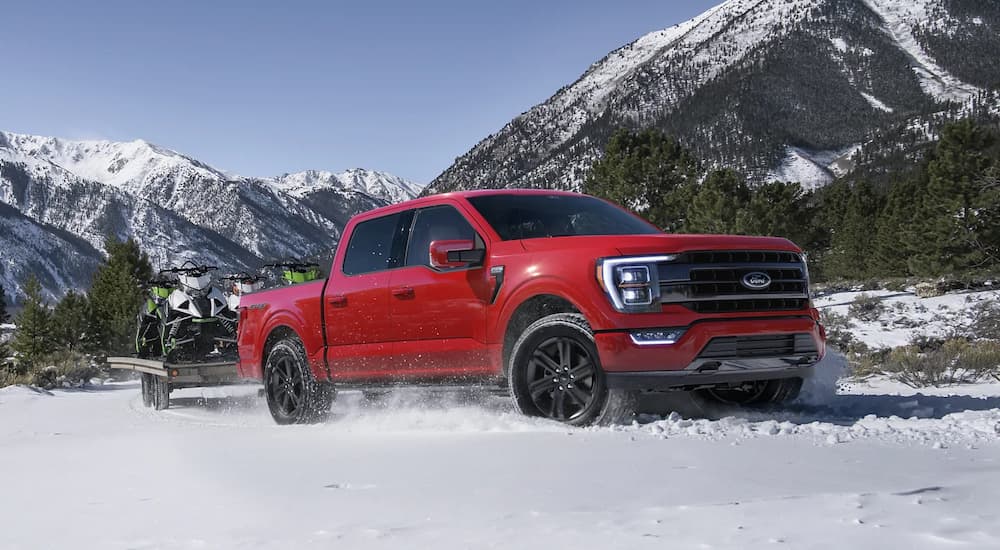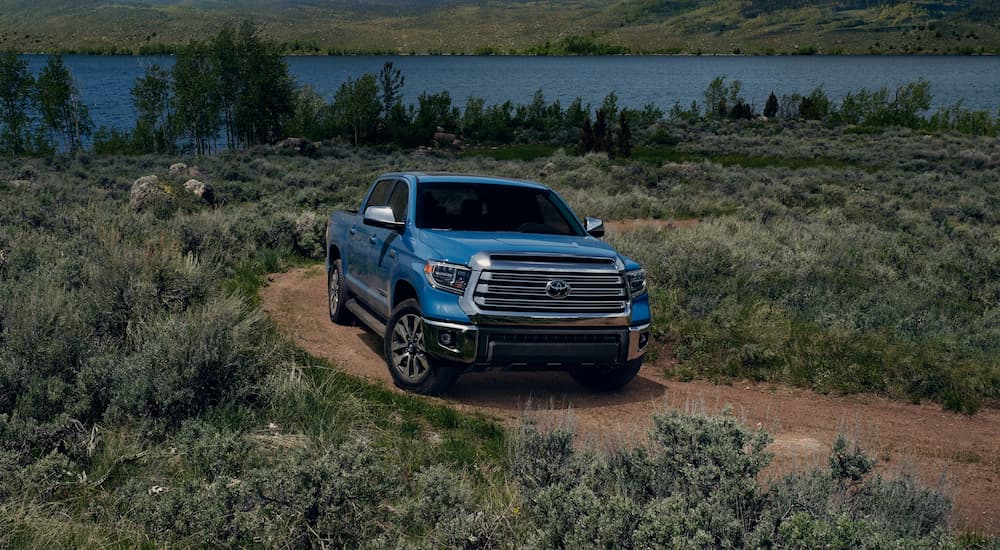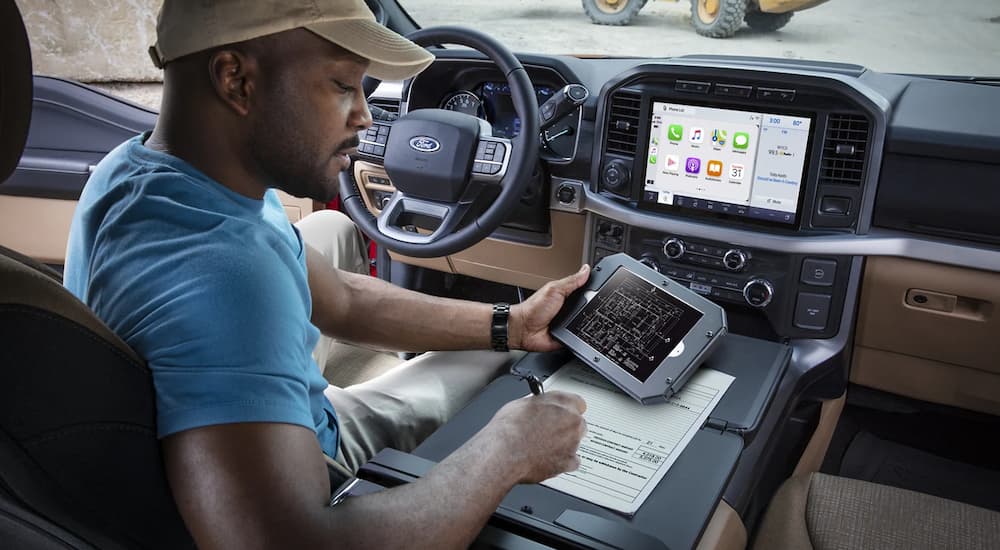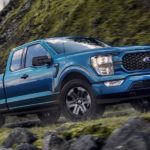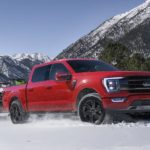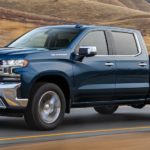When it comes to truck purchases, you may have only a few brand choices, but you have a lot of choices within the brands. Do you go with the Ford that has nearly limitless build options and loads of tech, or do you go with the Toyota that shrinks the options in favor of reliability? Despite being known for its hybrid powertrains, it isn’t Toyota that’s leading the pack for hybrid trucks, and the Tundra’s platform is aging. Ford continues to lead the pack in truck sales, delivering not only a full hybrid but also the fully electric Lightning. Even so, Toyota holds its own space in safety and durability and has a loyal truck following. Comparing the 2021 Ford F-150 vs 2021 Toyota Tundra should reveal which truck is a better value for the money.
Powertrains
Ford has been offering a wide variety of powertrains for decades, and having the option of choosing the right engine for the purpose you intend for your truck opens up a lot of possibilities for buyers. Six engines are available in the 2021 F-150 lineup, starting with the standard 3.3-liter V6 engine that comes with the entry-level XL trim. This is the lightest-duty engine of the lineup, making up to 290 hp with 265 lb-ft of torque, but it can still tow up to 8,200 pounds. Ford offers several other V6 gas engines with the 2.7-liter twin-turbo EcoBoost, the 3.5-liter EcoBoost, and the high-output 3.5-liter EcoBoost, all of which offer more towing capacity and payload than the standard engine.
For diesel lovers, the 3.0-liter Powerstroke turbo is available with towing power up to 12,100 pounds, and for a best-in-class fuel efficiency of 25 mpg combined, the hybrid powertrain pairs the 3.5-liter turbocharged V6 with an electric motor. Using a lithium-ion battery to power the electric motor, the hybrid engine makes 430 hp and 570 lb-ft of torque for towing power up to 12,700 pounds. For off-road enthusiasts, the Raptor variant comes with a high-output 3.5-liter EcoBoost that features 400 hp and 500 lb-ft of torque for excellent power on inclines and challenging terrain.
With all these engine options to give buyers a choice for the kind of power and performance they need, Ford ensures each engine has smooth gearing with a 10-speed automatic transmission. Four-wheel drive is available across the trims, and the addition of the available FX4 package adds skid plates and an off-road suspension system. After considering all these choices, Toyota may seem pale in comparison. The 2021 Tundra comes with only one powertrain across the entire lineup: a 5.7-liter V8 that makes 381 hp with 401 lb-ft of torque. This engine is paired to a six-speed automatic transmission and has towing power of up to 10,200 pounds at its max. While the V8 is up to the task of off-roading with the available four-wheel drive, the suspension is stiff, and the ride quality is harsh in comparison to Ford’s well-sorted suspensions.
Technology
Even if you plan to purchase an entry-level work truck, the increasing use of technology in daily life is becoming a necessity to stay current. Whether you like the idea of connecting your smartphone to your vehicle or not, almost every new car in 2021 has some type of capability to stream content or pair your phone through Bluetooth at least. Take into account the fact that most vehicles also include driver-assist safety features, and you can expect your truck to deliver a number of features that can make life more convenient on the road. Trucks today also benefit from clever technology to make trailering and off-roading easier too.
If we look at the infotainment options for both the 2021 F-150 and the 2021 Tundra, they both come with Apple CarPlay and Android Auto connectivity, but Ford gives buyers wireless smartphone integration. Ford also includes a larger 8-inch touchscreen in comparison to Toyota’s standard 7-inch screen. In upper trims, the available 12-inch touchscreen from Ford similarly beats the Toyota 8-inch upgrade. Convenience from Ford’s over-the-air updates to software means no extra trips to the service center to have techs update aging systems, a feature Toyota does not offer.
Safety is a different story, with driver-assist features being more prevalent in the 2021 Tundra. As ever, Toyota brings value with its standard safety suite, which includes lane departure warning, auto emergency braking, and automatic high beams as part of the Toyota Safety Sense package. In addition, Toyota includes trailer sway control, an integrated trailer brake controller, and vehicle stability control. Ford gives fewer safety features to its entry-level trucks with only auto emergency braking with pedestrian detection as standard, but trailer sway control, roll stability control, curve control, and a rearview camera with hitch assist guidelines are all standard. Available blind-spot monitoring is available in Ford’s BLIS feature for all trims.
Available tech for trailering and off-roading gets more interesting for buyers able to spend on the upper trims, and here is where Ford once again takes the upper hand. Along with its capable engines and performance upgrades, tech features like Pro Trailer Backup Assist to guide your trailer in reverse, Blue Cruise for semi-autonomous driving on the highway, and a larger 12-inch digital gauge cluster for performance models are just a taste of the exceptional convenience Ford gives to buyers. In comparison, the 2021 Tundra does not offer much in the way of assistance for any of these tasks by way of technology.
Convenience
It’s already been established that the 2021 Tundra suffers from poor ride quality in comparison to the fresher design of the 2021 F-150, and the outdated design of the Tundra carries over into conveniences that desperately need an upgrade. Ford truly pays attention to its buyers’ needs and provides ingenious solutions to what buyers want while they travel, work, and tow. Conveniences like an available fold-flat workspace in the center console, a tailgate that serves multiple functions like holding a tablet or acting as a workbench, and having available lockable storage under the back seat are just a few of the handy features in the 2021 F-150.
Toyota offers numerous options that make truck ownership easier, with its own system for available bed storage that is lockable, a deck rail system with tie-down cleats, and a powered tailgate for easier opening and closing. While the bed storage is a great option, one drawback is that to access the lockable bins in the sides of the bed, you really need to be in the bed. Reaching into the bins from the sides of the truck is not really possible and not very convenient. Compare these to one of Ford’s most innovative features — the onboard generator — and the 2021 F-150 might be one of the best trucks on the market for sheer convenience alone. If you choose the hybrid F-150, you get stand ard 2.4 kilowatts of power to run heavy-duty tools, work lights, or even a refrigerator!
This same generator is available for some of the gas-powered engines as well, though it comes standard with the hybrid. Buyers who want to increase available power can opt for the most powerful generator option with 7.2 kilowatts of power output to handle even more tools or toys while you’re out camping or working away from electricity. Just plug into the outlets in the rear of the bed, and your truck might as well be your home away from home. No matter how you slice the safety features and reputation of the Toyota Tundra, it doesn’t have the tech, convenience, ride quality, or options you will find in the 2021 Ford F-150. If anything, Toyota seems to treat the Tundra like an oversized sedan rather than a heavy-duty truck, and Ford’s innovations far exceed what Toyota brings to the table.
